Aging of γ′ Precipitates at 750 °C in the Nickel-Based Superalloy AD730TM: A Thermally or Thermo-Mechanically Controlled Process?
Abstract
1. Introduction
2. Material and Methods
2.1. Material
2.2. Interrupted Strain-Controlled Fatigue Tests
3. Results
3.1. Strain-Free Aging: Reference Curve
3.2. Microstructural Aging with Strain
- In Figure 11a, the increase in mean sizes of secondary γ′ is related to the average stress amplitudes during testing as well as the slight decrease in tertiary γ′ size in Figure 11b. It should be noted that the correlations are the same when plotted versus strain rates. Indeed, loading and unloading durations being kept constant at 10 s, the higher the strain/stress amplitudes, the higher the strain rates.
- Figure 11c,d deal with coalescing particles: they respectively show the decrease in mean size and the increase in surface fraction as a function of the mean stress during the 186 h fatigue tests. The mean stress used is the averaged value over time. Regarding the dwell-fatigue conditions, since 94% of the test duration is spent at maximal stress, the mean stress is considered to be the average maximal stress throughout the test.
4. Discussion
4.1. Choice of the Threshold Size
4.2. Coalescence Thermally and Time Dependent
4.3. Thermomechanical Contribution to Aging Mechanisms?
- The first one is that a high strain rate leads to a more difficult accommodation of stress and strain fields surrounding the precipitates, leading to a slightly higher instability of the γ/γ′ interface and promoting the Ostwald ripening phenomenon. This is supported by the fact that, in most cases, the introduction of a 300 s dwell-period at maximal strain tones down the increase in aging kinetics: dwell-periods allow the near-precipitate lattice to accommodate the changes in strain and stress local fields.
- The second one is that diffusion coefficients of elements are linearly dependent on the strain rate. Girifalco et al., Forestieri et al., and Angiolini et al. [63,64,66] established this result on silver and Cu–Zn alloys. Indeed, the diffusion coefficient under strain (Ds) can be written as following an Arrhenius law (Equation (3)) related to the strain value imposed (s), the activation energy per unit strain (Q’) and the diffusion coefficient in strain-free conditions (D) [69].
5. Conclusions
- (1)
- Strain-free aging at 750 °C activates two concomitant microstructure aging mechanisms: the coarsening and the coalescence of γ′. The spherical γ′II precipitates coarsen via a thermally activated Ostwald ripening process following a cubic LSW equation. This coarsening takes place at the expense of the small tertiary γ′ that end up by being completely dissolved. The inter-particle distance then increases during the aging. The coalescence of precipitates and particularly the necking rate between them remains steady during strain-free aging, but can increase when small precipitates involved in Ostwald ripening are getting fewer.
- (2)
- Aging mechanisms are not only thermally controlled, but also mechanically controlled:
- When a cyclic strain is applied, the Ostwald ripening kinetics is enhanced. The main reasons are the effect of stress/strain on the misfit, the increase in the γ/γ′ interface energy, and the γ′-forming element diffusion through the γ matrix, promoted by lattice deformation and “pipe diffusion” via dislocations. Hence, it has been shown that the higher the maximal strain, the greater the γ′ coarsening kinetics.
- A strain ratio of −1 compared to 0.05 is more efficient in enhancing the coarsening kinetics. That is, because the coarsening of γ′II precipitates depends on the stress amplitude and the strain rate.
- Moreover, 10-300-10 dwell-fatigue loading is less efficient to increase the coarsening kinetics compared to the 10-0-10 fatigue loading, thanks to a better accommodation of the deformation in dwell conditions.
- Dwell-fatigue increases the coalescence rate of γ′ particles at 750 °C due to the applied high mean stress. Fatigue loading with low mean stresses does not increase γ′ coalescence kinetics compared to strain-free conditions.
Author Contributions
Funding
Conflicts of Interest
References
- Radis, R.; Schaffer, M.; Albu, M.; Kothleitner, G.; Pölt, P.; Kozeschnik, E. Evolution of size and morphology of γ′ precipitates in Udimet 720 Li during continuous cooling. In Proceedings of the 11th International Symposium, Seven Springs, PA, USA, 14–18 September 2008; pp. 829–836. [Google Scholar]
- Pollock, T.M.; Tin, S. Nickel-Based Superalloys for Advanced Turbine Engines: Chemistry, Microstructure, and Properties. J. Propuls. Power 2006, 22, 361–374. [Google Scholar] [CrossRef]
- Thébaud, L.; Villechaise, P.; Cormier, J.; Hamon, F.; Crozet, C.; Devaux, D.; Franchet, J.M.; Rouffié, A.L.; Organista, A. Relationships between microstructural parameters and time-dependent mechanical properties of a new nickel based AD730TM. In Proceedings of the 13th International Symposium on Superalloys, Seven Springs, PA, USA, 11–15 September 2016; pp. 877–886. [Google Scholar]
- Devaux, A.; Picqué, B.; Gervais, M.F.; Georges, E.; Poulain, T.; Héritier, P. AD730TM, a new nickel-based superalloy for high temperature engine rotative parts. In Proceedings of the International Symposium on Superalloys, Seven Springs, PA, USA, 9–13 September 2012; pp. 911–919. [Google Scholar]
- Benyoucef, M.; Coujou, A.; Barbker, B.; Clement, N. In situ deformation experiments on a γ/γ′ superalloy. Strengthening mechanisms. Mater. Sci. Eng. A 1997, 234, 692–694. [Google Scholar] [CrossRef]
- Jackson, M.P.; Reed, R.C. Heat treatment of Udimet 720Li: The effect of microstructure on properties. Mater. Sci. Eng. A 1999, 259, 85–97. [Google Scholar] [CrossRef]
- Masoumi, F.; Shahriari, D.; Jahazi, M.; Cormier, J.; Devaux, A. Kinetics and Mechanisms of γ′ Reprecipitation in a Ni-based Superalloy. Sci. Rep. 2016, 6, 1–16. [Google Scholar] [CrossRef] [PubMed]
- Goodfellow, A.; Galindo-Nava, E.; Christofidou, K.; Jones, N.; Martin, T.; Bagot, P.; Boyer, C.; Hardy, M.; Stone, M. Gamma prime precipitate evolution during aging of a model nickel-based superalloy. Metall. Mater. Trans. A 2017, 49, 718–728. [Google Scholar] [CrossRef]
- Torster, F.; Baumeister, G.; Albrecht, J.; Lütjering, G.; Helm, D.; Daeubler, M. Influence of grain size and heat treatment on the microstructure and mechanical properties of the nickel-base superalloy U 720 LI. Mater. Sci. Eng. A 1997, 234, 189–192. [Google Scholar] [CrossRef]
- Hardy, S.; Voorhees, P. Ostwald Ripening in a System with a High Volume Fraction of Coarsening Phase. Metall. Trans. A 1988, 19A, 2713–2721. [Google Scholar]
- Devaux, A.; Helstroffer, A.; Cormier, J.; Villechaise, P.; Douin, J.; Hantcherli, M.; Pettinari-Sturmel, F. Effect of aging heat-treatment on mechanical properties of AD730TM superalloy. In Proceedings of the 8th International Symposium on Superalloy 718 and Derivatives, Pittsburgh, PA, USA, 28 September–1 October 2014; pp. 521–535. [Google Scholar]
- Telesman, J.; Kantzos, P.; Gayda, J.; Bonacuse, P.J.; Prescenzi, A. Microstructural variables controlling time-dependent crack growth in a P/M superalloy. In Proceedings of the International Symposium, Seven Springs, PA, USA, 19–23 September 2004; pp. 215–224. [Google Scholar]
- Grosdidier, T.; Hazotte, A.; Simon, A. Precipitation and dissolution processes in γ/γ′ single crystal nickel-based superalloys. Mater. Sci. Eng. 1998, A256, 183–196. [Google Scholar] [CrossRef]
- Voorhees, P. Ostwald ripening of two-phase mixtures. Annu. Rev. Mater. Sci. 1992, 22, 197–215. [Google Scholar] [CrossRef]
- Wang, Q.; Robert, F.; Xu, H.; Li, X. On the critical radius in generalized Ostwald ripening. J. Zhejiang Univ. Sci. 2005, 6B, 705–707. [Google Scholar] [CrossRef]
- Marder, M. Correlations and Ostwald ripening. Phys. Rev. A 1987, 36, 858–874. [Google Scholar] [CrossRef] [PubMed]
- Baldan, A. Review: Progress in Ostwald ripening theories and their applications to the γ′-precipitates in nickel-base superalloys—Part I: Ostwald ripening theories. J. Mater. Sci. 2002, 37, 2171–2202. [Google Scholar] [CrossRef]
- Baldan, A. Review: Progress in Ostwald ripening theories and their applications to the γ′-precipitates in nickel-base superalloys—Part II: Nickel-base superalloys. J. Mater. Sci. 2002, 37, 2379–2405. [Google Scholar] [CrossRef]
- Ardell, A. Interfacial Free Energies and Solute Diffusivities from Data on Ostwald Ripening. Interface Sci. 1995, 3, 119–125. [Google Scholar] [CrossRef]
- Ardell, A.; Ozolins, V. Trans-interface diffusion-controlled coarsening. Nat. Mater. 2005, 4, 309–316. [Google Scholar] [CrossRef]
- Ardell, A. Trans-interface-diffusion-controlled coarsening of γ′ precipitates in ternary Ni-Al-Cr alloys. Acta Mater. 2013, 61, 7828–7840. [Google Scholar] [CrossRef]
- Brailsford, A.; Wynblatt, P. The dependence of Ostwald ripening kinetics on particle volume fraction. Acta Meter. 1979, 27, 489–497. [Google Scholar] [CrossRef]
- Lifshitz, I.; Slyozov, V. The kinetics of precipitation from supersaturated solid solutions. J. Phys. Chem. Solids 1961, 19, 35–50. [Google Scholar] [CrossRef]
- Wagner, C. Theory of precipitate change by redissolution. Z. Electrochem. 1961, 65, 581–591. [Google Scholar]
- Tiley, J.; Viswanathan, G.; Srinivasan, R.; Banerjee, R.; Dimiduk, D.; Fraser, H. Coarsening kinetics of γ′ precipitates in the commercial nickel base Superalloy Rene’ 88 DT. Acta Mater. 2009, 57, 2538–2549. [Google Scholar] [CrossRef]
- Moore, I.; Burke, M.; Nuhfer, N.; Palmiere, E. Evaluation of classical precipitation descriptions for γ′’ (Ni3Nb—D022) in Ni-base superalloys. J. Mater. Sci. 2017, 52, 8665–8680. [Google Scholar] [CrossRef] [PubMed]
- Laurence, A.; Cormier, J.; Villechaise, P.; Billot, T.; Franchet, J.M.; Pettinari-Sturmel, F.; Hantcherli, M.; Mompiou, F.; Wessman, A. Impact of the solution cooling rate and of thermal aging on the reep properties of the new cast and wrought René 65 Ni-based superalloy. In Proceedings of the 8th International Symposium on Superalloy 718 and Derivatives, Pittsburgh, PA, USA, 28 September–1 October 2014; pp. 333–348. [Google Scholar]
- Mataveli Suave, L.; Cormier, J.; Villechaise, P.; Soula, A.; Hervier, Z.; Bertheau, D.; Laigo, J. Microstructural evolutions during thermal aging of alloy 625: Impact of temperature and forming process. Mater. Trans. A 2014, 45, 2963–2982. [Google Scholar] [CrossRef]
- Mukherjee, K.; Hsu, T.; Kato, M. Fiber morphology resulting from solid state coalescence of spherical precipitates. Phys. Stat. Solidi 1984, 81, 439–444. [Google Scholar] [CrossRef]
- Mao, Z.; Sudbrack, C.; Yoon, K.; Martin, G.; Seidman, D. The mechanism of morphogenesis in a phase-separating concentrated multicomponent alloy. Nat. Mater. 2007, 6, 210–216. [Google Scholar] [CrossRef] [PubMed]
- Masoumi, F.; Jahazi, M.; Shahriari, D.; Cormier, J. Coarsening and dissolution of γ′ precipitates during solution treatment of AD730TM Ni-absed superalloy: Mechanisms and kinetics models. J. Alloys Compd. 2016, 658, 981–995. [Google Scholar] [CrossRef]
- Wang, T.; Sheng, G.; Liu, Z.; Chen, L. Coarsening kinetics of γ′ precipitates in the Ni-Al-Mo. Syst. Acta Mater. 2008, 56, 5544–5551. [Google Scholar] [CrossRef]
- Hisazawa, H.; Terada, Y.; Takeyama, M. Morphology evolution of y’ precipitates during isothermal exposure in wrought Ni-based superalloy Inconel X-750. Mater. Trans. 2017, 58, 817–824. [Google Scholar] [CrossRef]
- Pollock, T.; Argon, A. Directional coarsening in nickel-base single crystals with high volume fractions of coherent precipitates. Acta Mater. 1993, 42, 1859–1874. [Google Scholar] [CrossRef]
- Sauthoff, G. Influence of stresses on precipitation. J. Phys. Coll. 1996, C1, 87–97. [Google Scholar] [CrossRef][Green Version]
- Mughrabi, H. Microstructural aspects of high temperature deformation of monocrystalline nickel base superalloys: Some open problems. Mater. Sci. Technol. 2009, 25, 191–204. [Google Scholar] [CrossRef]
- Flageolet, B. Effet Du Vieillissement Du Superalliage Base Nickel N18 Pour Disques de Turbines Sur Sa Durabilité en Fatigue Et Fatigue-Fluage à 700 °C. Ph.D. Thesis, ISAE ENSMA, Poitou-Charentes, France, 2005. [Google Scholar]
- Wu, C. The role of Eshelby stress in compoposition-generated and stress-assisted diffusion. J. Mech. Phys. 2001, 49, 1771–1794. [Google Scholar] [CrossRef]
- Kolbe, M.; Dlouhy, A.; Eggeler, G. Dislocation reactions at γ/γ′-interfaces during shear creep deformation in the macroscopic crystallographic shear system (001)of CMSX6 superalloy single crystals at 1025 °C. Mater. Sci. Eng. 1998, A246, 133–142. [Google Scholar] [CrossRef]
- Nabarro, F. Rafting in superalloys. Metall. Mater. Trans. A 1996, 27A, 513–530. [Google Scholar] [CrossRef]
- Kontis, P.; Li, Z.; Collins, D.; Cormier, J.; Raabe, D.; Gault, B. The effect of chromium and cobalt segregation at dislocations on nickel-based superalloys. Scr. Mater. 2018, 145, 76–80. [Google Scholar] [CrossRef]
- Mianroodi, J.; Shantraj, P.; Kontis, P.; Cormier, J.; Gault, B.; Svendsen, B.; Raabe, D. Atomistic phase field chemomechanical modeling of dislocation-solute-precipitate interaction in Ni-Al-Co. Acta Mater. 2019, 175, 250–261. [Google Scholar] [CrossRef]
- Jouiad, M.; Marin, E.; Devarapalli, R.; Cormier, J.; Ravaux, F.; Le Gall, C.; Franchet, J.M. Microstructure and mechanical properties evolutions of alloy 718 during isothermal and thermal cycling over-aging. Mater. Des. 2016, 102, 284–296. [Google Scholar] [CrossRef]
- Legros, M.; Dehm, G.; Arzt, E.; Balk, T. Observation of giant diffusivity along dislocation cores. Science 2008, 319, 1646–1649. [Google Scholar] [CrossRef]
- Skrotzki, B.; Shiflet, G.; Starke, E. On the effect of stress on nucleation and growth of precipitates in an Al-Cu-Mg-Ag Alloy. Mater. Trans. A 1996, 27A, 3431–3443. [Google Scholar] [CrossRef]
- Sauthoff, G. Long-range ordering in the early stages of precipitation—A brief review. Metall. Mater. Trans. A 1994, 25, 2565–2568. [Google Scholar]
- Cormier, J.; Milhet, X.; Mendez, J. Non-isothermal creep at very high temperature of the nickel-based single crystal superalloy MC2. Acta Mater. 2007, 55, 6250–6259. [Google Scholar] [CrossRef]
- Véron, A.; Bréchet, Y.; Louchet, F. Strain induced directional coarsening in ni based superalloys. Scr. Mater. 1996, 34, 1883–1886. [Google Scholar] [CrossRef]
- Caccuri, V.; Cormier, J.; Desmorat, R. γ′-rafting mechanisms under complex mechanical stress state in Ni-based single crystalline superalloys. Mater. Des. 2017, 131, 487–497. [Google Scholar] [CrossRef]
- Pineau, A. Influence of uniaxial stress on the morphology of coherent precipitates during coarsening—Elastic energy considerations. Acta Meter. 1976, 24, 559–564. [Google Scholar] [CrossRef]
- Reed, R.; Matan, N.; Cox, D.; Rist, M.; Rae, C. Creep of CMSX-4 superalloy single crystals: Effects of rafting at high temperature. Acta Mater. 1999, 47, 3367–3381. [Google Scholar] [CrossRef]
- Svetlov, I.; Golovko, B.; Epishin, A.; Abalakin, N. Diffusional mechanism of γ′-phase particles coalescence in single crystals of nickel-base superalloys. Scr. Mater. 1992, 26, 1353–1358. [Google Scholar] [CrossRef]
- Tien, J.; Copley, S. The effect of orientation and sense of applied uniaxial stress on the morphology of coherent gamma prime precipitates in stress annealed nickel-base superalloy crystals. Meter. Trans. 1971, 2, 543–553. [Google Scholar] [CrossRef]
- Tien, J.; Gamble, R. Effects of stress coarsening on coherent particle strengthening. Meter. Trans. 1971, 3, 2157–2162. [Google Scholar] [CrossRef]
- Cao, L.; Wollgramm, P.; Bürger, D.; Kostka, A.; Cailletaud, G.; Eggeler, G. How evolving multiaxial stress states affect the kinetics of rafting during creep of single crystal Ni-base superalloys. Acta Mater. 2018, 158, 381–392. [Google Scholar] [CrossRef]
- Ha, J.; Seong, J.; Jeong, J.; Choi, Y.; Kang, N. Effects of the aging temperature and stress relaxation conditions on γ′ precipitation in Inconel X-750. J. Nucl. Mater. 2015, 457, 362–368. [Google Scholar] [CrossRef]
- Farvizi, M.; Asgari, S. Effects of cold work prior to aging on microstructure of AEREX™350 superalloy. Mater. Sci. Eng. A 2008, 480, 434–438. [Google Scholar] [CrossRef]
- Tien, J.; Gamble, J. The influence of applied stress and stress sense on grain boundary precipitate morphology in a nickel-base superalloy during creep. Meter. Trans. 1971, 2, 1663–1667. [Google Scholar]
- Schulz, F.; Li, H.; Kitaguchi, H.; Child, D.; Williams, S.; Bowen, P. Influence of Tertiary Gamma Prime (γ′) Size Evolution on Dwell Fatigue Crack Growth Behavior in CG RR1000. Mater. Trans. A 2018, 49A, 3874–3884. [Google Scholar] [CrossRef]
- Frenz, H.; Kinder, J.; Klingelhöffer, H.; Portella, P. Behavior of single crystal superalloys under cycling loading at high temperatures. In Proceedings of the International Symposium on Superalloys, Seven Springs, PA, USA, 22–26 September 1996; pp. 305–312. [Google Scholar]
- Vengrenovitch, R. On the ostwald ripening theory. Acta Meter. 1982, 30, 1079–1086. [Google Scholar] [CrossRef]
- Durand, M. Analyse Des Mécanismes Métallurgiques Survenant Dans L’alliage AD730TM Au Cours De Revenu De Relaxation Des Contraintes. Ph.D. Thesis, Ecole Nationale des Mines de Paris—CEMEF, Paris, France. in progress.
- Girifalco, L.; Grimes, H. The Theory of Diffusion on Strained Systems; US Government Printing Office: Washington, DC, USA, 1958.
- Forestieri, A.; Girifalco, L. The effect of plastic deformation on self-diffusion in silver. J. Phys. Chem. Solids 1959, 10, 99–105. [Google Scholar] [CrossRef]
- Kubicek, M.; Cai, Z.; Ma, W.; Yildiz, B.; Hutter, H.; Fleig, J. Tensile lattice strain accelerates oxygen surface exchange and diffusion in La1-xSrxCoO3-delta thin films. ACS 2013, 7, 3276–3286. [Google Scholar]
- Angiolini, M.; Mazzone, G.; Montone, A.; Vittori-Antisari, M. Effect of plastic deformation on the kinetics of the solid state reaction between Cu and Zn. Phys. Rev. B 1999, 59, 11733–11738. [Google Scholar] [CrossRef]
- Nechaev, Y.; Vladimirov, S.; Olshevskii, N.; Khlomov, V. On the effect of high-rate strain on diffusion mass transfer in metals. Phys. Stat. Solidi 1986, 553–560. [Google Scholar] [CrossRef]
- Johnson, W. Precipitate shape evolution under applied stress—Thermodynamics and kinetics. Meter. Trans. A 1987, 18A, 233–247. [Google Scholar] [CrossRef]
- Ola, O.T.; Ojo, O.A.; Wanjara, P.; Chaturvedi, M.D. Analysis of microstructural changes induced by linear friction welding in a nickel-based superalloy. Metall. Mater. Trans. A 2011, 42A, 3761–3777. [Google Scholar] [CrossRef]
- Prikhodko, S.; Ardell, A. Coarsening of γ’ in Ni-Al alloys aged under uniaxial compression: I. Early-stage kinetics. Acta Mater. 2003, 51, 5001–5012. [Google Scholar] [CrossRef]


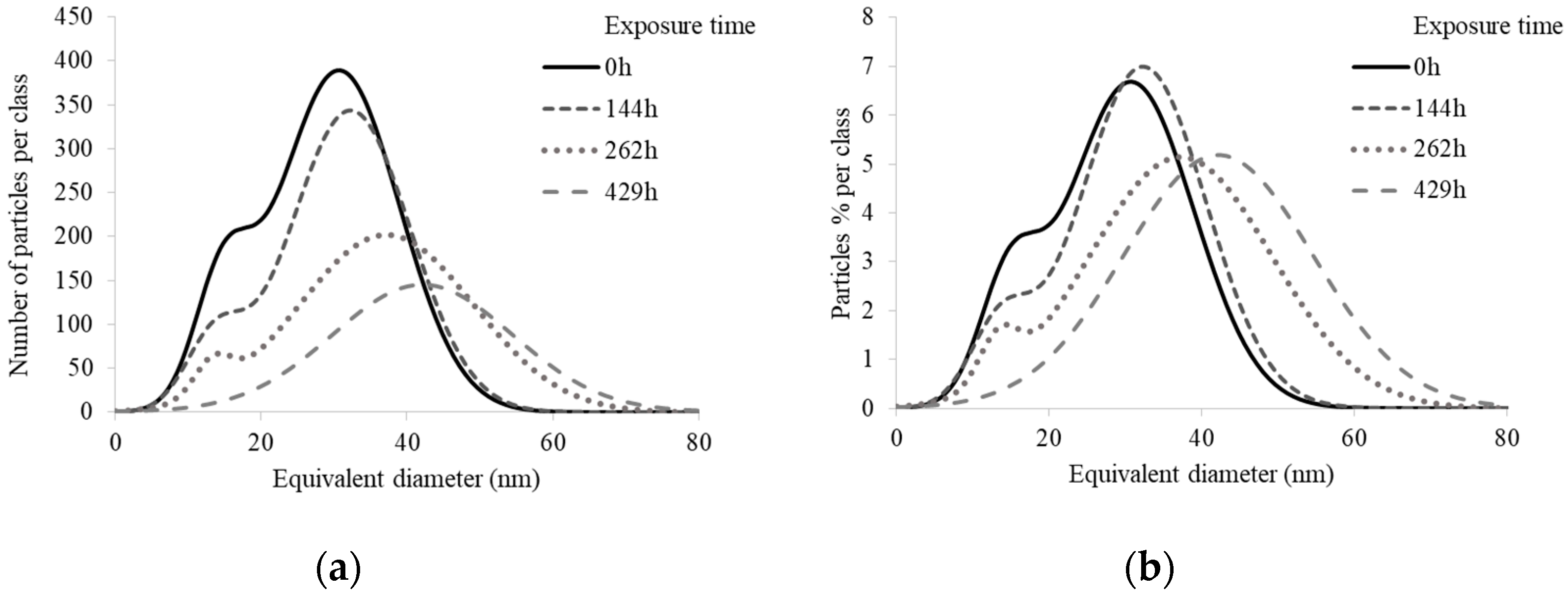
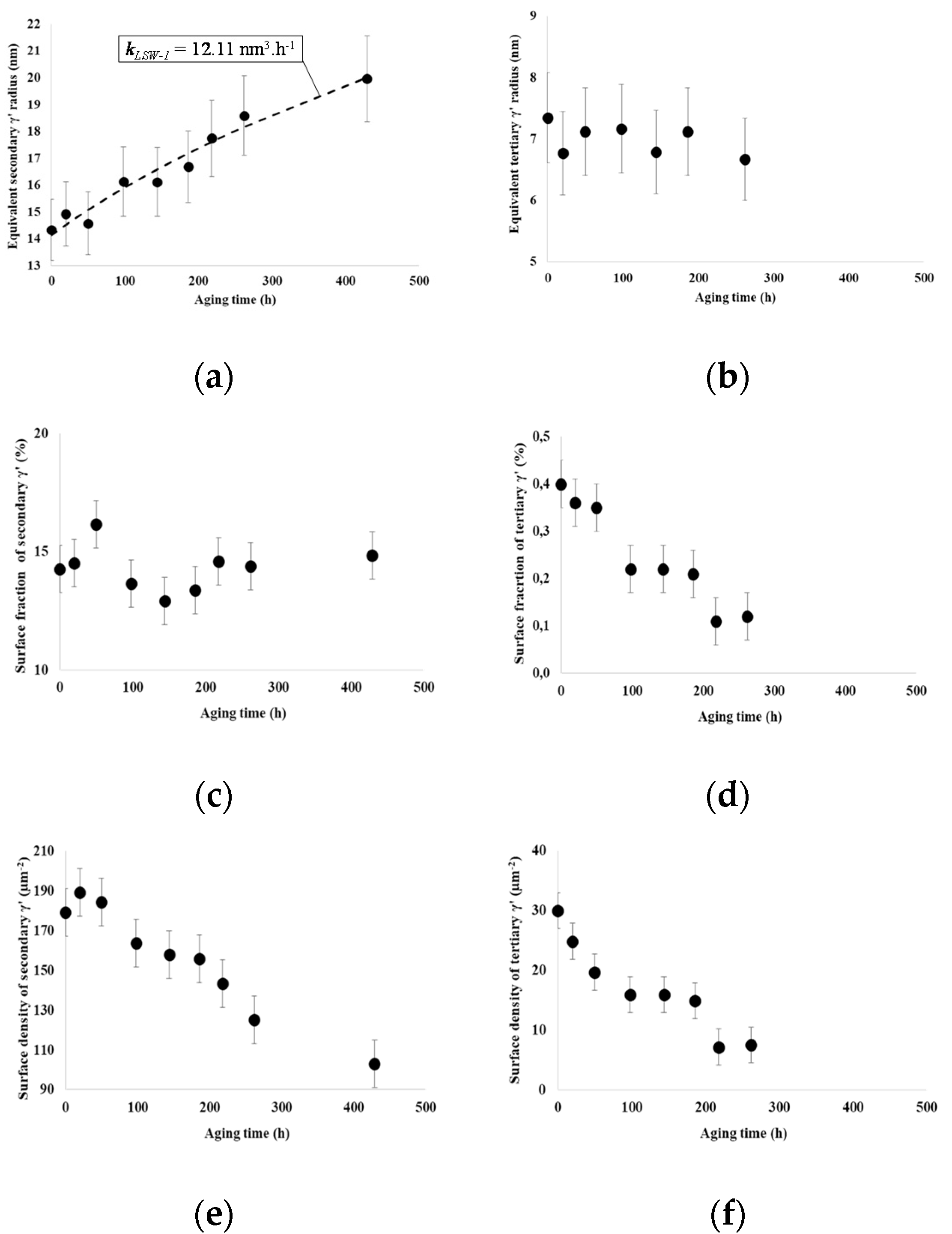
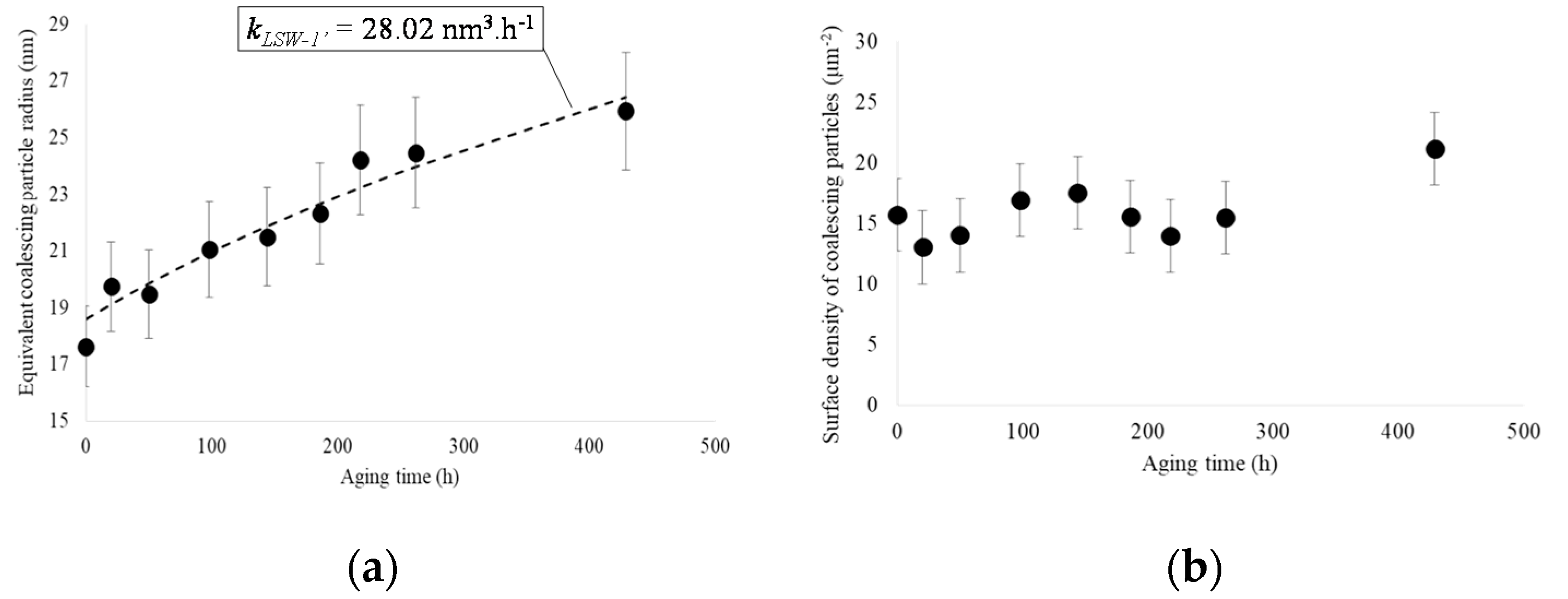
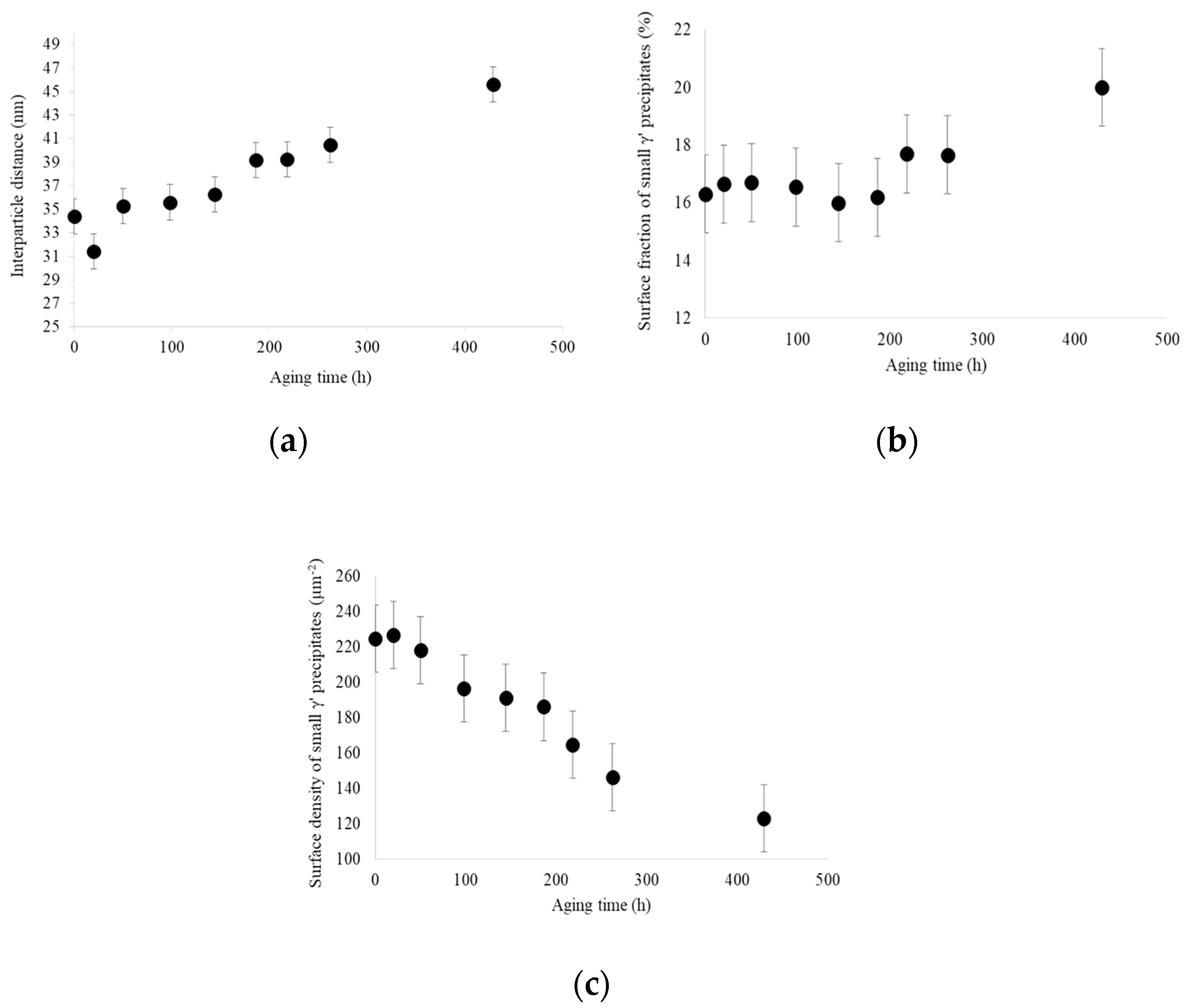
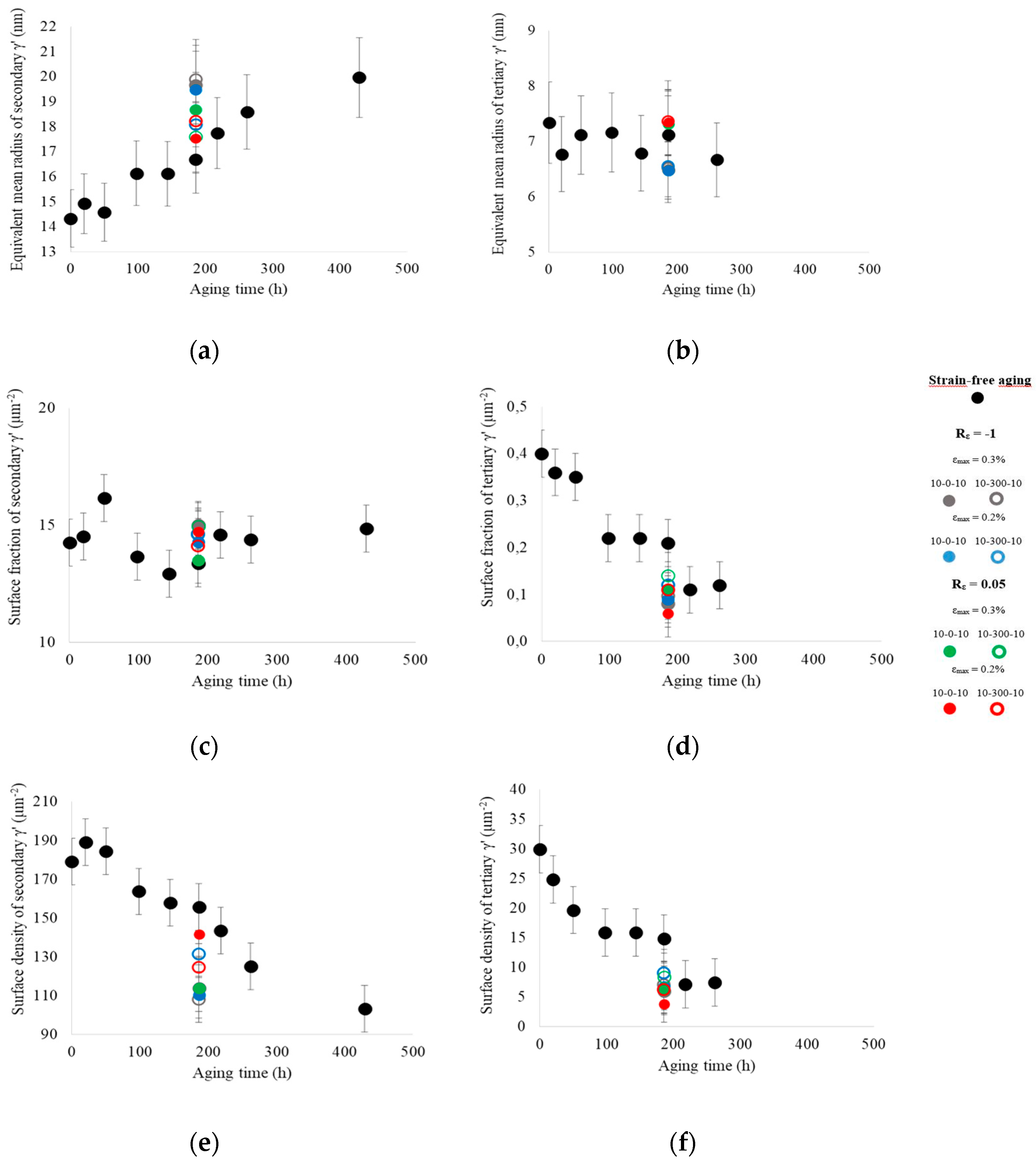
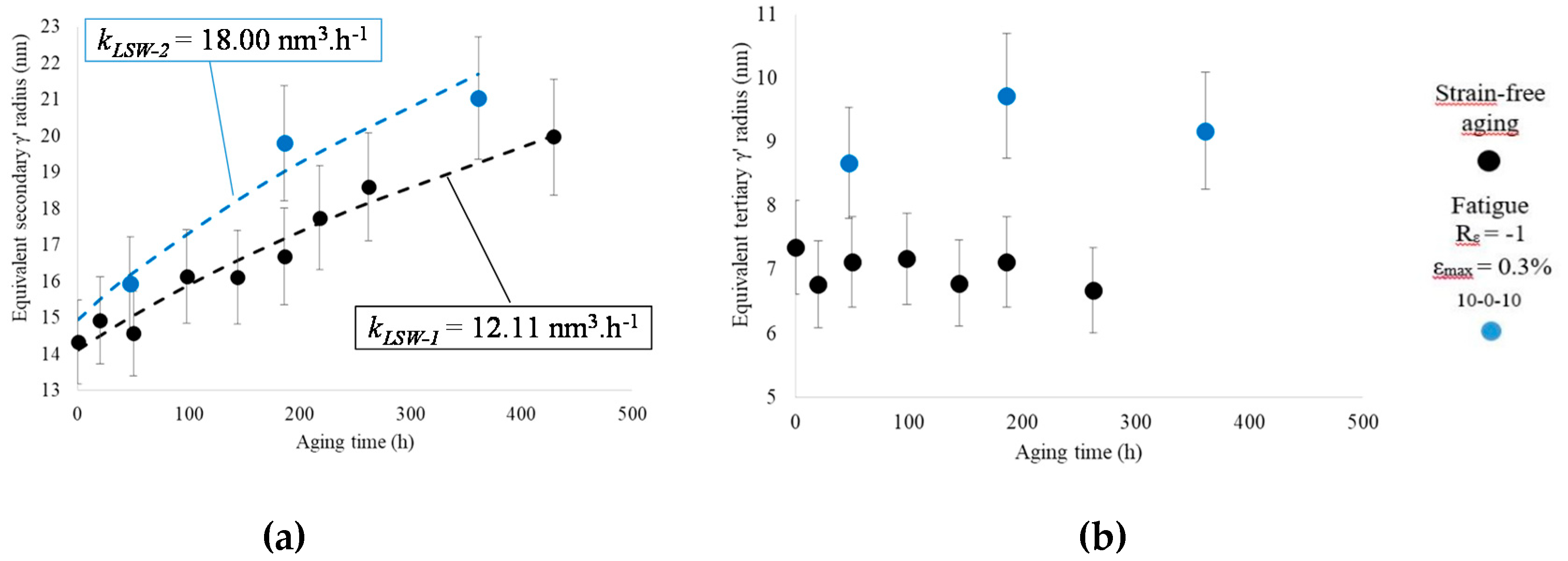
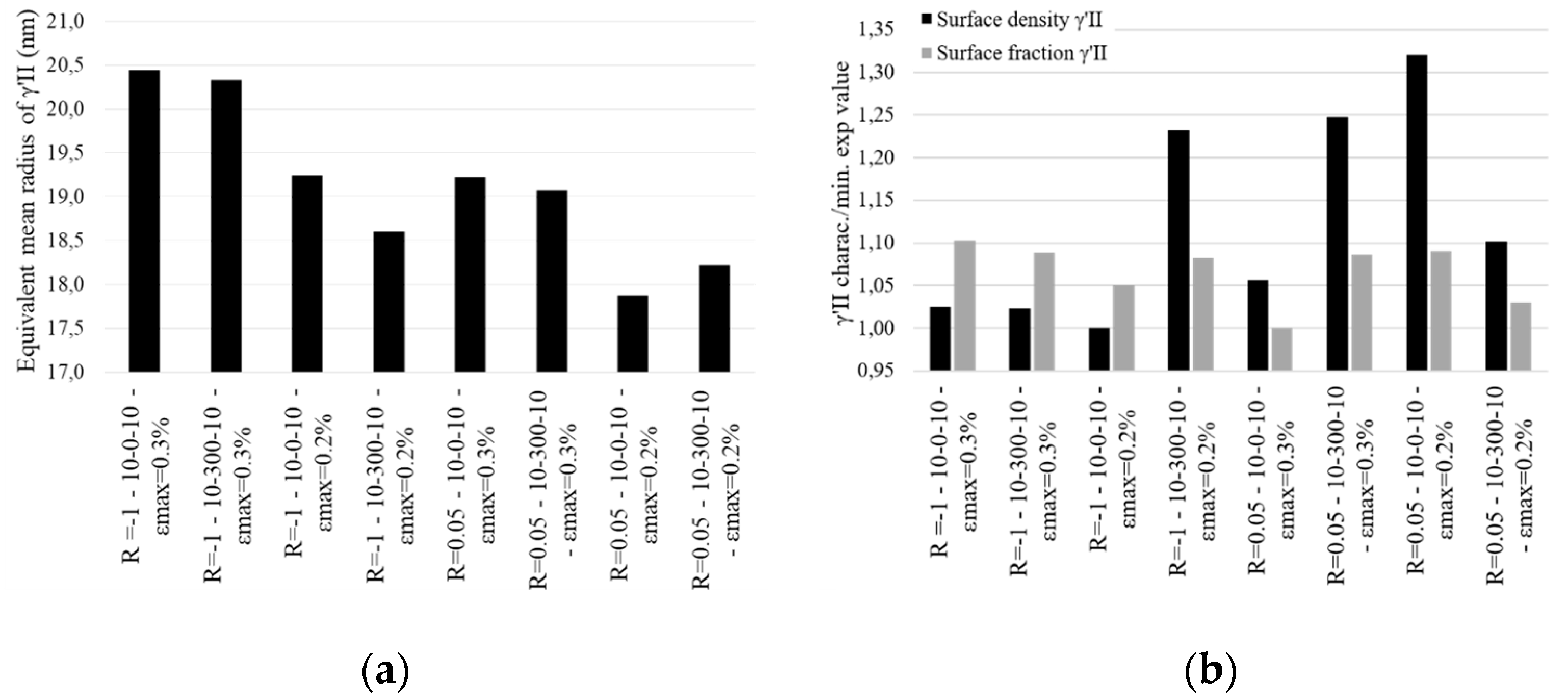
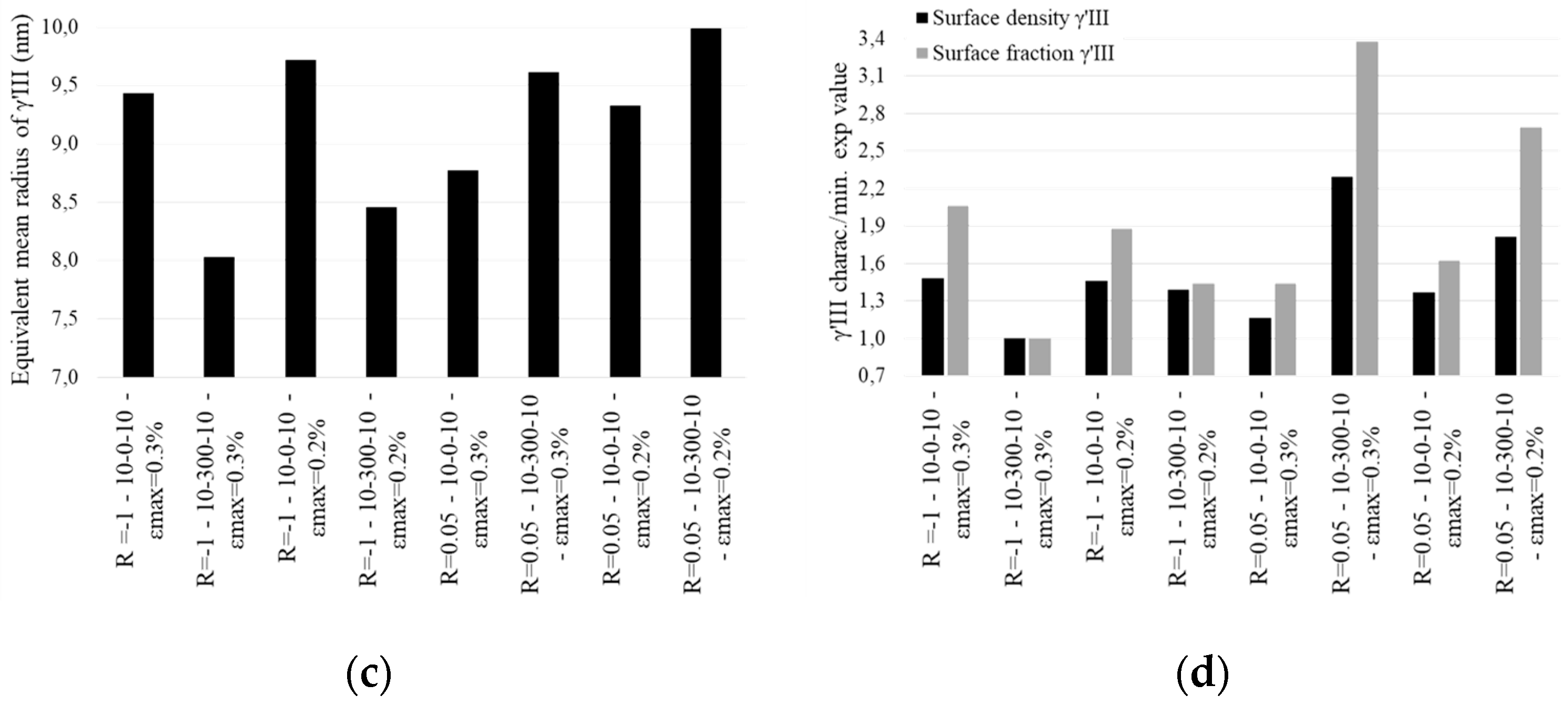
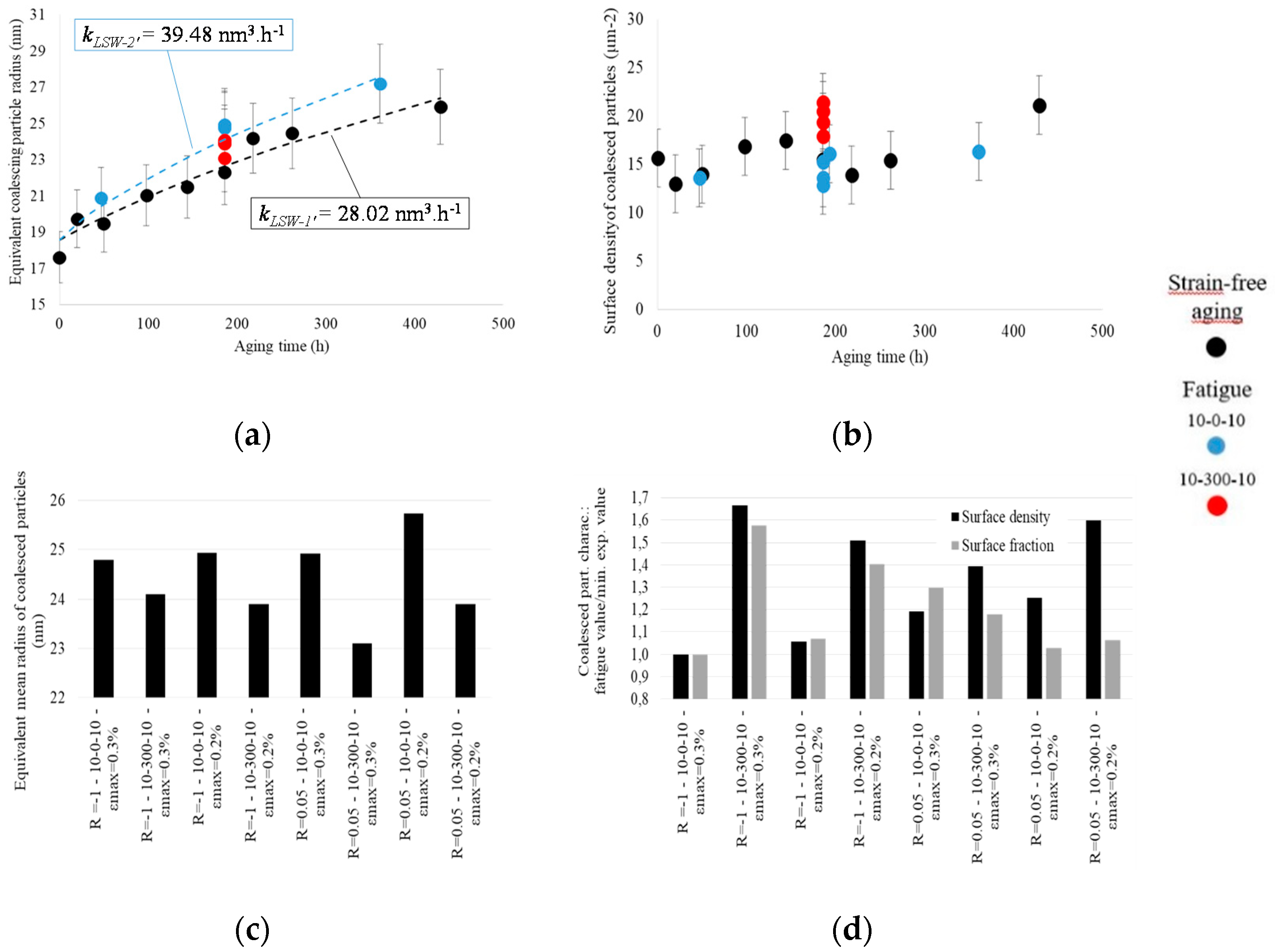
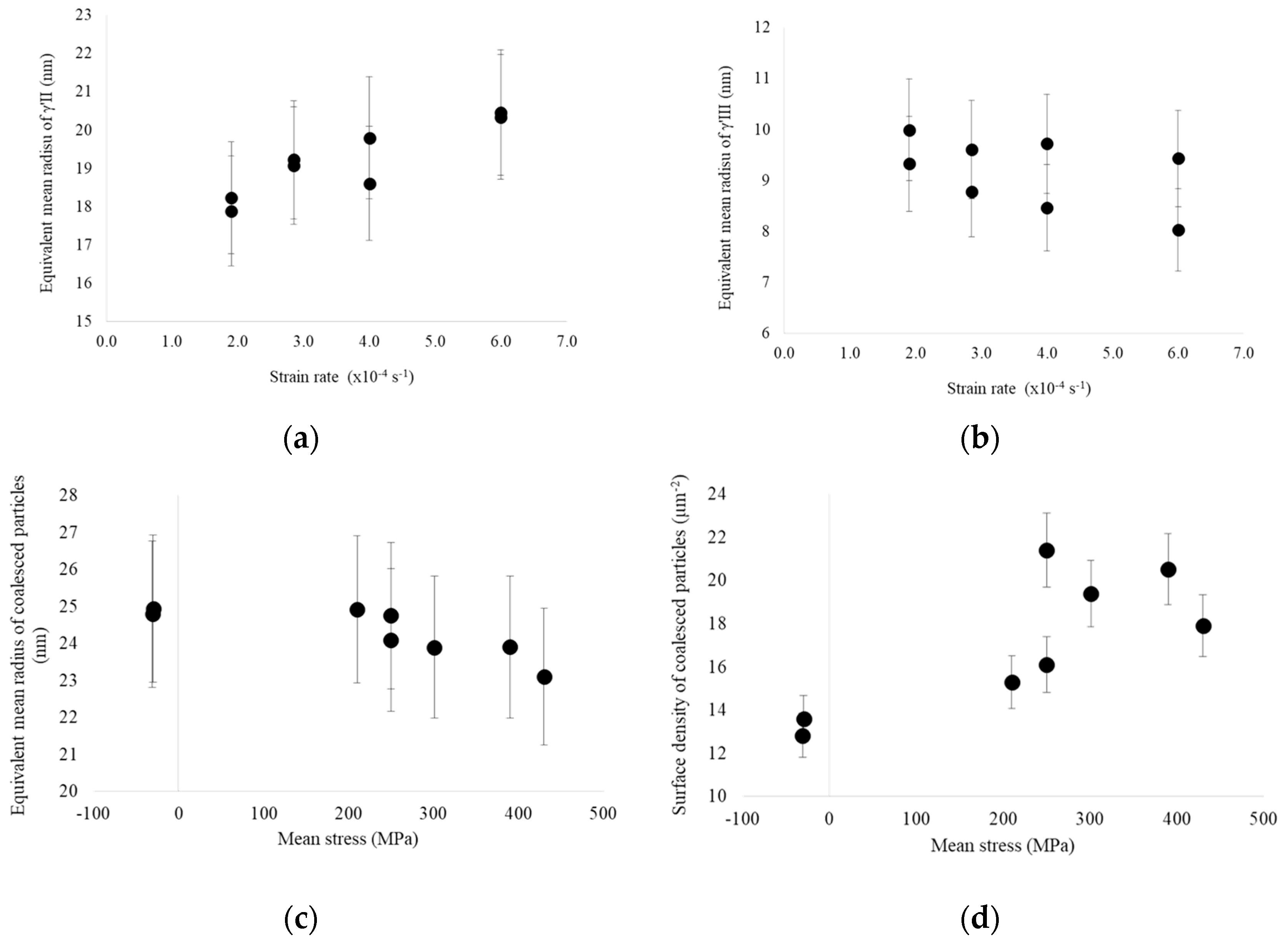
| Element | Ni | Cr | Mo | W | Al | Co | Ti | Nb | Fe | C | B |
|---|---|---|---|---|---|---|---|---|---|---|---|
| Wt. % | Balance | 16.0 | 3.0 | 2.7 | 2.3 | 8.5 | 3.5 | 1.1 | 4.0 | <0.02 | 0.01 |
| Particle Populations | Equivalent Diameter (nm) | Surface Fraction (%) | Surface Density (µm−2) | γ Width (nm) |
|---|---|---|---|---|
| Cubical γ’ | 293 ± 15 | 10.1 ± 0.5 | 1.40 ± 0.1 | - |
| Spherical secondary γ’ | 28.7 ± 2.3 | 14.3 ± 1.0 | 179.0 ± 12 | 34.3 ± 1.5 |
| Spherical tertiary γ’ | 14.7 ± 1.5 | 0.40 ± 0.05 | 30.0 ± 4.0 | - |
| Coalescing | 35.3 ± 2.8 | 1.58 ± 0.3 | 15.7 ± 3.0 | - |
| Test | Rε | εmax | Δε | Strain Waveform | Duration |
|---|---|---|---|---|---|
| Fatigue | −1 | 0.2% | 0.4% | 10-0-10 | 186 h |
| Fatigue* *Only test carried out up to failure | −1 | 0.3% | 0.6% | 10-0-10 | 186 h |
| Fatigue Dwell | −1 | 0.2% | 0.4% | 10-300-10 | 186 h |
| Fatigue Dwell | −1 | 0.3% | 0.6% | 10-300-10 | 186 h |
| Fatigue | −1 | 0.2% | 0.4% | 10-0-10 | 47 h |
| Fatigue | −1 | 0.2% | 0.4% | 10-0-10 | 361 h |
| Fatigue | 0.05 | 0.2% | 0.19% | 10-0-10 | 186 h |
| Fatigue | 0.05 | 0.3% | 0.285% | 10-0-10 | 186 h |
| Fatigue Dwell | 0.05 | 0.2% | 0.19% | 10-300-10 | 186 h |
| Fatigue Dwell | 0.05 | 0.3% | 0.285% | 10-300-10 | 186 h |
© 2020 by the authors. Licensee MDPI, Basel, Switzerland. This article is an open access article distributed under the terms and conditions of the Creative Commons Attribution (CC BY) license (http://creativecommons.org/licenses/by/4.0/).
Share and Cite
Mrozowski, N.; Hénaff, G.; Hamon, F.; Rouffié, A.-L.; Franchet, J.-M.; Cormier, J.; Villechaise, P. Aging of γ′ Precipitates at 750 °C in the Nickel-Based Superalloy AD730TM: A Thermally or Thermo-Mechanically Controlled Process? Metals 2020, 10, 426. https://doi.org/10.3390/met10040426
Mrozowski N, Hénaff G, Hamon F, Rouffié A-L, Franchet J-M, Cormier J, Villechaise P. Aging of γ′ Precipitates at 750 °C in the Nickel-Based Superalloy AD730TM: A Thermally or Thermo-Mechanically Controlled Process? Metals. 2020; 10(4):426. https://doi.org/10.3390/met10040426
Chicago/Turabian StyleMrozowski, Nicolas, Gilbert Hénaff, Florence Hamon, Anne-Laure Rouffié, Jean-Michel Franchet, Jonathan Cormier, and Patrick Villechaise. 2020. "Aging of γ′ Precipitates at 750 °C in the Nickel-Based Superalloy AD730TM: A Thermally or Thermo-Mechanically Controlled Process?" Metals 10, no. 4: 426. https://doi.org/10.3390/met10040426
APA StyleMrozowski, N., Hénaff, G., Hamon, F., Rouffié, A.-L., Franchet, J.-M., Cormier, J., & Villechaise, P. (2020). Aging of γ′ Precipitates at 750 °C in the Nickel-Based Superalloy AD730TM: A Thermally or Thermo-Mechanically Controlled Process? Metals, 10(4), 426. https://doi.org/10.3390/met10040426





